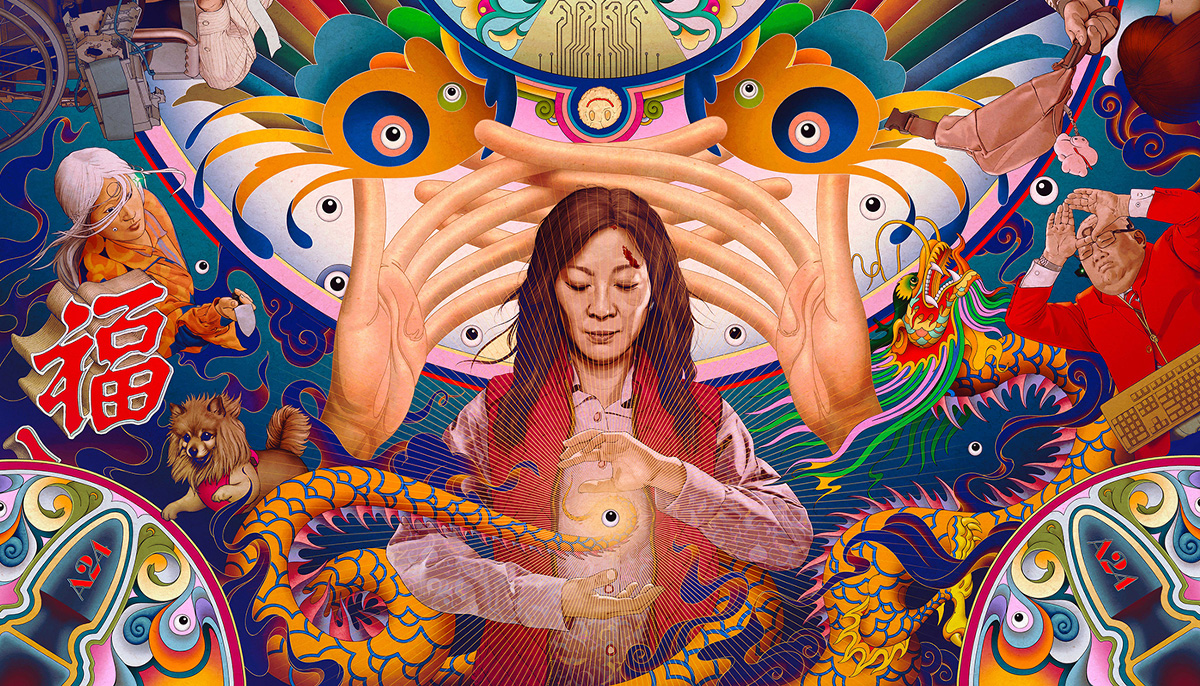In the days since Everything Everywhere All at Once took home seven Oscars at the 2023 Academy Awards ceremony, I’ve been delighted to see the film and its actors so widely recognized and honored. Watching actors Michelle Yeoh and Ke Huy Quan receive their awards was tremendously moving given how pervasive anti-Asian bias is in American culture and the film industry. Part of what folks have been celebrating is the kind-heartedness of the film and its cast, from Ke Huy Quan’s moving comeback after 30 years of being sidelined to the inspiration of seeing two women in their 60s in powerful leading roles, cheering each other on.
As a Buddhist practitioner, I immediately saw Everything Everywhere All at Once as a dharma movie. It radiates sincerity and warmth, with a core Buddhist message at it heart: everything is empty, but still meaningful. This is the classic Mahāyāna Buddhist view of the interdependence of wisdom and compassion, or nirvāṇa and saṃsāra. That the film manages to convince us of both without falling into either side as a fixed view is a rare feat.
The multiverse story offers an image of an infinite proliferation of selves, leading us to a terrible implication which becomes the true antagonist in the film: nothing means anything.
Multiverse stories like Everything Everywhere All at Once rely on an intuition that touches the core of who we think we are. They suggest that every choice we’ve ever made and every condition that moved us along our path could have been different. The result of even a tiny difference in conditions or choices could mean a completely different life. The visceral sense of other possible lives is both haunting and tantalizing — so close to the path we took, but always receding from contact. “What if I had done this?,” we wonder. “Said that? Gone there? Not gone there?” Quivering on the knife edge of the future, our every choice shaping the world to come, we constantly create new karma — action that has consequences for ourselves and others. Driven by desire and fear, the mind naturally obsesses with doubt about what is or was the right path to take.
In both meditation and ordinary life, rumination about choices is one of the most potent kinds of distraction we suffer from. The mind spins out unreal futures and pasts, tragic and beautiful alternate realities that intoxicate us with the fantasy of control, attainment, or failure. It’s addictive. For a little while, the world isn’t so painful, inevitable, and inescapable. Then we come back to reality and the truth sets in. There is no escape, at least not that way.
The fantasy technology in Everything Everywhere All at Once proposes that it’s possible to draw on the knowledge and experiences of our parallel selves to amplify our present world capabilities. When Evelyn (Michelle Yeoh) or Waymond (Ke Huy Quan) needs fighting skills in the film, they connect with a parallel self who knows martial arts. In other timelines, they’re an opera singer and a billionaire. From there, it just gets weirder — the hot dog fingers universe, the racoon-as-Ratatouille universe. Initially, our narrative tropes hold up: this is the “real” Evelyn, the “real” Waymond, the “real” Joy (Stephanie Hsu), their estranged queer daughter. As the universes start to pile up and flicker in and out of connection, the standard narrative breaks down. Which version of the character is “real”? Which should we care about?
As multiverse stories offer the image of an infinite proliferation of selves, we’re led to a terrible implication which becomes the true antagonist in Everything Everywhere All at Once: nothing means anything. When nothing means anything, that includes our identities, relationships, and choices. In Buddhist language, all these conditioned phenomena (saṇkhāra) are empty (suñña), meaning they’re empty of independent existence, lasting substance, and intrinsic meaning. The villain for most of the film is a parallel universe version of Evelyn’s daughter, Joy, whose “mind broke” when she gained the ability to know all possible universes at once. She gained omniscience and omnipotence, but without the guardrails of wisdom or compassion. Without meaningful connection as a stable reality to ground her, she succumbs to the near enemy of emptiness: nihilism.
Nihilism is the special argument of Māra, who mythically confronted the Buddha under the bodhi tree as he gathered himself for his cosmic vision of karma and emptiness. The Buddha’s liberating insight was not into parallel concurrent universes, but a similar cosmic structure with the same dangerous implication, spun out in time rather than in space.
When the Buddha saw his past lives, it wasn’t just a string of causally connected individual rebirths, but countless cosmic eons of the past expanding and contracting with infinitely iterating selves interacting with others in an endless relational recombination. The implication of this is that we have all been everybody’s parent, child, sibling, partner, friend, enemy, in every possible arrangement. In both the time (rebirth) and space (multiverse) visions of the infinite, individuality is blasted into fractal interconnection. The individual self was empty to begin with — empty of permanence, empty of the conditions for lasting satisfaction, empty of any solid basis for the narratives we spin around ourselves like spider silk. But the narratives are also real. Actions have real impact in the world and beings who are empty are also real. This is the insight that keeps us on the path and makes true freedom possible.
As absurd and hyperbolic as it is on the surface, Everything Everywhere All at Once traces a classic Buddhist journey beginning with suffering, then training the mind, opening to a vision of how things really are, attainment of supernormal power and liberating insight, and return to the world, liberated. As the film opens, everyone is suffering. Evelyn is stressed. Her taxes, her family, and her laundromat business all are a mess. Her husband Waymond is falling into despair as he realizes he’s losing Evelyn to the stress. Joy is almost fully lost to bitterness, unseen and rejected by her mother, holding it together with millennial irony and the support of her girlfriend Becky (Tallie Medel), an unambiguously kind character in a movie where everyone has violent alternate selves. Becky is a still point, a moral fulcrum in a story that partly hinges on whether Evelyn will be honest with her father, Gong Gong (James Hong), about Joy’s queerness. Becky’s steadiness holds a through line of queer visibility and acceptance that ties the arc of the story together.
The sci-fi adventure that unfolds is a metastasis of the family drama. Joy becomes the antagonist Jobu Tupaki, who sees that all the infinite universes are “statistical inevitabilities,” and moves through them like a psychopathic Neo from The Matrix, turning people into confetti and killing indiscriminately while spouting nihilistic philosophical nuggets. Jobu has taken every possible eventuality in all the infinite universes and put it all on an “everything” bagel, which becomes the totem of her nihilist cult. Waymond’s sweet goodness turns into heroic martyrdom as “Alpha Waymond” shows Evelyn how to access her power, knowing that she’s the only one who can save the universe, saving their marriage while he’s at it. Evelyn becomes a bodhisattva — an infinitely compassionate and skillful warrior who finally loses all self-consciousness, hesitation, and doubt, healing her opponents instead of harming them, and pulling her daughter back from the brink.
Evelyn has seen emptiness, seen through the ink black enso of the everything bagel, and seen through the illusion that there was anyone or anything to fight or even a universe to save. She is free.
Dharma practice both reveals and empowers. It reveals aspects of ourselves and our conditioned identities even as it deconstructs them. With focused attention, the heart gains the ability to stop believing that only our current narrative is true and sees how vast the universe of possibilities and interconnection truly is. When the Buddha saw his infinite births and how our choices are what determines our suffering or joy in the future, the natural result was both power and love. Power comes when we know we can access the skillful qualities of all our infinite lives (called the pāramīs, or perfections) and the mind is stable enough to see everything unfolding through the chaos without succumbing to fear. Love comes when we see through even emptiness to the relationships that are the substance of the world.
Evelyn’s moment of breaking through arises with what in lovingkindness (mettā) practice we would call “the difficult person.” In her first fight with Jamie Lee Curtis’s brilliant and terrifying character, Deirdre the I.R.S. agent, Evelyn gets the instruction to tell Deirdre she loves her — and mean it — in order to accomplish the “verse jump” through which she can gain the power of one of her alternate selves. It’s almost impossible for her familiar identity to do this, which is exactly what difficult person practice is meant to challenge. She almost can’t do it, but in the last moment, she finds it in her heart and shouts “I love you!” Time slows almost to a stop, and Evelyn is plunged into a montage of other births. She sees herself training in kung fu, but also in a spectacular life without her husband Waymond that becomes an homage to Wong Kar-wai’s dreamy New Wave movie, In the Mood for Love. She and Deirdre also spin out a romantic universe where they are struggling lovers who happen to have hot dog fingers.
The film shines as dharma by not retreating on the wisdom proposition that everything, seen with infinite perspective, is empty of specialness or centrality, but still requires our heartfelt, engaged participation. After fully understanding the multiverse and attaining omniscience herself, Evelyn drops all the parallel lines and comes back to the ordinary world, where she carries herself with equanimity, warmth, and fearlessness. She now knows what her daughter could not yet understand: the unity of emptiness and compassion.
In the closing scene, after she has plunged into the black hole of the everything bagel to save her daughter, we see the ordinary world version of the same moment. Evelyn stops Joy from angrily leaving the laundromat New Year’s party, and brings them back into connection with clear, heartfelt, brave mothering. She introduces Becky to Gong Gong as Joy’s girlfriend, a gesture toward ancestral repair, and Waymond tears up the divorce papers he’s been carrying around. In the Zen language of the Ox-Herding Pictures, Evelyn “returns to the marketplace with gift-bestowing hands.”
She’s seen emptiness, seen through the ink black enso of the everything bagel, and seen through the illusion that there was anyone or anything to fight or even a universe to save. She is free, and her love — for Joy, for Waymond, for her father, for Deirdre, for the perfect drabness of her laundromat and life of seeming failure — shines forth.

